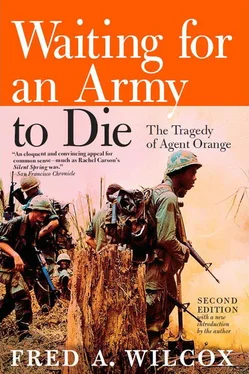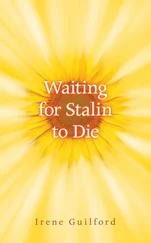“But the important thing here is that in the world’s literature one can find only about ten different compounds that will cause a positive Ehrlich reaction, and to our surprise we’re finding that 90 percent of the Vietnam veterans we see have this positive Ehrlich reaction. So naturally Dr. Petryka was intrigued by this and he went about searching the urine samples to see if they contained any one of these ten chemicals. And he discovered that the veterans’ urine contains none of the them. So we concluded that the compound that is causing the positive Ehrlich reaction must be a new compound and I jokingly told Dr. Petryka that he should name it after himself, calling it the Petryka compound. But he went and named it after me, so now it’s called the ‘Codario-Ehrlich positive metabolism.’ But we do know the molecular weight—it is 220—of this compound, and Dr. Petryka is in the process of defining its chemical structure. And when he finds that chemical structure it may be very interesting because it could very well be a way of determining whether or not a person has been exposed to herbicides. Obviously, with the coproporphyrin elevation and the curious positive Ehrlich reaction, we now have a biochemical way of saying yes, these people are different. And there are abnormalities in these patients that we are not finding in those who didn’t serve in Vietnam.”
In addition to his willingness to work for very little financial gain (Codario sees all Vietnam veterans initially for free and often spends his weekends flying free of charge to the home state of any veteran who has called for help), Dr. Codario has another remarkable quality. During our interview the phone would ring, as one might expect in a busy doctor’s office, and he would listen patiently, replying to the caller’s questions or complaints with genuine concern. Then almost before he had replaced the receiver, he would continue exactly where he had left off, even if this meant in the middle of a complicated compound sentence.
“The other thing that is of interest is that Dr. Strik of the Netherlands, who is one of the world’s authorities on porphyrin problems resulting from exposure to chemicals, and has published several papers on what happens to people whose porphyrin levels are elevated due to their exposure to herbicides, has clearly stated that porphyria progresses in a stepwise fashion from asystematic coproporphyria auria to the much more devastating uroporphyria auria. And that disease is called porphyria cutanea tarda, which is a condition characterized by episodes of severe crampy abdominal pain, high fevers, schizophrenia, and often death. So it seems that the coproporphyria auria that we are seeing now merely represent the tip of the iceberg, or the beginning of the abnormality that if left unchecked may progress to porphyria cutanea tarda and death.”
Codario feels that he may have discovered a way to check the progressively destructive effects of herbicide poisoning; however, he fears that he may only be able to arrest, rather than cure, the problem. “I’m hoping that once we have established a significant statistical correlation, which we seem to be moving toward right now, that we can get approval to treat some of these porphyrin problems with the drug that they have developed in Minnesota called Hematin. But that may be an oversimplification because Hematin was designed to treat patients with acute severe porphyria—for example, patients suffering from porphyria cutanea tarda. The results have been nothing short of miraculous and are well-publicized in the journals of internal medicine. But in those cases the porphyrins they were producing in their urines were thirty to forty times higher than those we are seeing in our veterans. And we have to keep in mind that Hematin has never been used to treat chemically induced porphyrin problems, so we’re really treading in new territory and can’t be certain that it will work this way. But based on the mechanism of its action, it is certainly possible that it will be beneficial here. The thing we don’t know is, even if we are able to reverse the production of excess porphyrins, will we stop it forever just by giving the patient Hematin? And even if we return the porphyrin count to normal, will their symptoms go away? In examining the veterans and listening to their stories, I suspect that even if Hematin works it will only be temporarily effective and that after a period of time the individual will probably relapse. And I also suspect that all of the symptoms about which Vietnam veterans are complaining are not due solely to porphyrin problems but rather are a direct toxic effect of the herbicide in general and dioxin in particular.”
Another thing Codario would like to determine is how many of the veteran’s problems are due to the storage of TCDD in their fatty tissues because he believes it may be possible to flush these residues from the human body. But his efforts to test this theory have been hampered by the fact that the VA has done only a very limited fat biopsy study on Vietnam veterans, and when I spoke with him, he had already been waiting for nearly six months for the return of five biopsies.
“I sent the five fat biopsies to Dr. Thomas Tiernan at the Brehm Laboratory at Wright State University because Dr. Tiernan had done research on dioxin for the government and he is considered an ‘independent’ researcher. He was involved in studying dioxin levels on the ship Vulcanus , [15] In 1970 when the order to stop using Agent Orange in South Vietnam was issued, the US military was left with thousands of fifty-five-gallon drums containing this herbicide. Some of these barrels were stored on Johnston Island in the Pacific, while others went to the Naval Construction Battalion Center at Gulfport, Mississippi. But the drums started to rust and their contents began leaking, making it imperative that something more “final” be done about the surplus stocks of herbicide Orange. In February 1972, the Mississippi Air and Pollution Control Commission ordered that the Agent Orange stored at Gulfport be removed immediately. Faced with this, the Air Force tried returning the remaining stocks of Agent Orange to its manufacturers, who refused to accept the offer. Air Force officials also suggested that the surplus herbicide be disposed of “by the prudent disposition of herbicide Orange for use on privately owned or governmentally owned lands.” This plan also failed and, seven years after the barrels were removed from Vietnam, the EPA finally granted the Air Force a permit to incinerate the remaining stocks of Agent Orange on the German-built ship Vulcanus in the South Pacific. By the time the permit was granted, more than five thousand drums containing over a quarter million gallons of Agent Orange had rotted through.
and seems to be an expert in the field.”
Although dioxin can be stored in the human body for many years, standard laboratory tests, commonly used by the VA in its “Agent Orange examinations” fail to detect traces of dioxin in the blood, urine, or spinal fluid. “They take your blood and urine,” one veteran told me, “and when they don’t find dioxin in it—which they knew goddamn well they wouldn’t in the first place—they conclude that you’re clean, you weren’t exposed to Orange in Nam. Just more fun and games, because they know that TCDD is stored in the fatty tissues of the body. Their own research has shown that.”
The research the veteran refers to is a “blind” study conducted by Dr. Michael Gross of the University of Nebraska, on contract to the Veterans Administration. In this study, thirty grams of fat were removed from twenty Vietnam veterans who believed they had been exposed to Agent Orange. An additional thirty grams were removed from ten veterans who presumably had no contact with Agent Orange and from three US Air Force officers who had done dioxin research. The samples were forwarded to Dr. Gross’s laboratory, where they were analyzed for residues of TCDD-dioxin. Two of the three men who had been described as heavily exposed had TCDD in their fatty tissues of approximately twenty-five to one hundred parts per trillion, while three of the five who were classified as receiving “light exposure” had concentrations of from five to seven parts per trillion. Ten out of the twenty Vietnam veterans had TCDD in their fatty tissues . Two of the control samples contained low levels of TCDD in the abdominal adipose ranging from five to six parts per trillion. 1
Читать дальше











